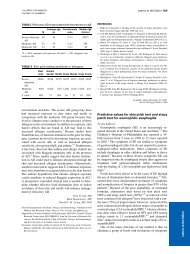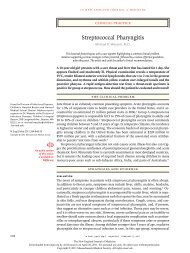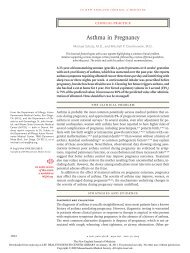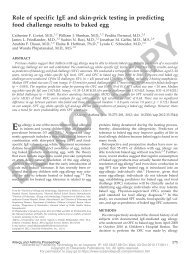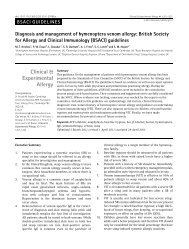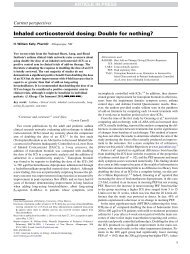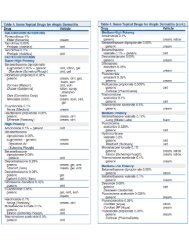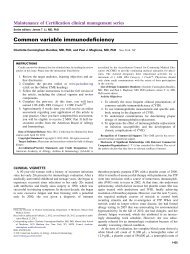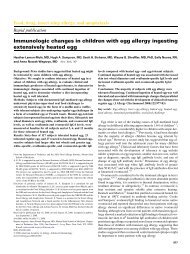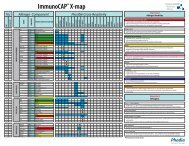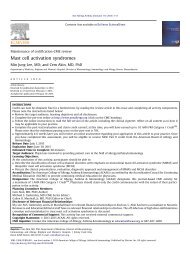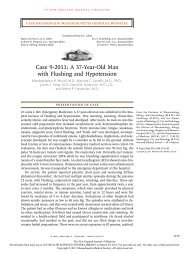Factors affecting the determination of threshold doses for - AInotes
Factors affecting the determination of threshold doses for - AInotes
Factors affecting the determination of threshold doses for - AInotes
You also want an ePaper? Increase the reach of your titles
YUMPU automatically turns print PDFs into web optimized ePapers that Google loves.
26 Taylor et al J ALLERGY CLIN IMMUNOLJANUARY 2002<strong>the</strong> <strong>of</strong>fending food, including milk in 9 incidents at levelsranging from 0.04% to 1.1% (wt/wt), egg in 3 incidentsat levels ranging from 0.003% to 0.16% (wt/wt),wheat gluten in 2 incidents at levels ranging from 0.3%to 1.3% (wt/wt), soy protein in 2 incidents at levels rangingfrom 0.5% to 7.0% (wt/wt), and hazelnut in 1 incidentat a level <strong>of</strong> 0.2% (wt/wt). Quantitative exposurein<strong>for</strong>mation was available in several <strong>of</strong> <strong>the</strong>se cases. Fatalanaphylaxis occurred in a consumer with milk allergyafter eating approximately 100 g <strong>of</strong> a sausage productcontaining 0.06% undeclared casein that equated to 60mg <strong>of</strong> casein. 8 An asthmatic reaction occurred in an individualwith hazelnut allergy after ingestion <strong>of</strong> about 3 to6 g <strong>of</strong> a chocolate confection containing 0.2% <strong>of</strong> undeclaredhazelnut that equated to 6 to 12 mg <strong>of</strong> hazelnut. 8Although such episodes reveal <strong>the</strong> hazards posed byundeclared residues <strong>of</strong> allergenic foods contaminatingo<strong>the</strong>r foods, <strong>the</strong>y are not particularly suitable <strong>for</strong> establishing<strong>the</strong> lowest provoking dose. For example, <strong>the</strong> circumstances<strong>of</strong> exposure, including <strong>the</strong> amount and type<strong>of</strong> foods eaten during <strong>the</strong> episode, can only be determinedanecdotally. Also, <strong>the</strong> reliability <strong>of</strong> <strong>the</strong> analyticresults can be questioned because validated, collaborativelystudied, standard methods are not yet available.CLINICAL APPROACHES TO THRESHOLDDOSE ESTIMATIONThe best estimates <strong>of</strong> <strong>the</strong> <strong>threshold</strong> dose <strong>for</strong> variousallergenic foods can be obtained from controlled clinicalchallenge trials. In only a few cases were such trials intendedspecifically to determine <strong>the</strong> <strong>threshold</strong> dose. 5,9 More frequently,challenges have been conducted <strong>for</strong> diagnosticpurposes ra<strong>the</strong>r than <strong>for</strong> determining <strong>the</strong> lowest provokingdose. However, typical protocols involve starting at <strong>doses</strong>that are one half or less <strong>of</strong> <strong>the</strong> amount <strong>of</strong> <strong>the</strong> <strong>of</strong>fending foodestimated by <strong>the</strong> patient to provoke symptoms. 10Because low <strong>doses</strong> <strong>of</strong> allergenic foods are sometimesused in <strong>the</strong> diagnosis <strong>of</strong> food allergies, especially inpatients with histories <strong>of</strong> serious allergic reactions, <strong>the</strong>possibility exists that data on <strong>the</strong> <strong>threshold</strong> <strong>doses</strong> <strong>for</strong>common allergenic foods might exist in certain allergyclinics. Consequently, in September 1999, <strong>the</strong> FoodAllergy Research and Resource Program at <strong>the</strong> University<strong>of</strong> Nebraska, with sponsorship from <strong>the</strong> food industry,convened a roundtable conference entitled “ThresholdDoses <strong>for</strong> Allergenic Foods: How Much Is Too Much?”RESULTS OF THE ROUNDTABLESeveral clinical groups did possess potentially usefulin<strong>for</strong>mation relating to <strong>the</strong> <strong>threshold</strong> <strong>doses</strong> <strong>for</strong> commonlyallergenic foods derived from <strong>the</strong> results <strong>of</strong> past doubleblind,placebo-controlled, food challenges (DBPCFCs)used <strong>for</strong> diagnostic purposes. The most useful data wereavailable on peanuts, eggs, and cows’ milk and will bereported here. Some data were also available on fish andmustard seed. Data were also available <strong>for</strong> soybeans,wheat, sesame seed, tree nuts, and crustaceans, but <strong>the</strong>number <strong>of</strong> patients tested was too few, and in some cases,<strong>the</strong> nature <strong>of</strong> <strong>the</strong> challenge materials was not preciselyknown (eg, <strong>the</strong> variety <strong>of</strong> tree nuts, <strong>the</strong> <strong>for</strong>m <strong>of</strong> soybean,and <strong>the</strong> method <strong>of</strong> processing or species <strong>of</strong> crustacean).Table I contains <strong>the</strong> results <strong>of</strong> <strong>the</strong> accumulated data on<strong>the</strong> lowest provoking <strong>doses</strong> in DBPCFCs <strong>for</strong> <strong>the</strong> variousinvestigators involved in <strong>the</strong> roundtable conference <strong>for</strong>peanuts, eggs, and cows’ milk. For peanut, results wereshared on DBPCFCs (and some single-blind, placebocontrolledfood challenges [SBPCFCs] and open challenges)<strong>of</strong> 306 patients. The lowest provoking dose was 1mg <strong>of</strong> peanut, which was seen with 4 patients; all <strong>of</strong> <strong>the</strong>sepatients were from <strong>the</strong> clinic <strong>of</strong> Dr Fabienne Rance inFrance. The range <strong>of</strong> lowest provoking <strong>doses</strong> <strong>for</strong> <strong>the</strong>sepatients was 1 mg to 5 g. For eggs, results were shared onDBPCFCs (and some SBPCFCs and open challenges) <strong>of</strong>281 patients. The lowest provoking dose was 1 mg <strong>of</strong> liquidwhole egg, which was seen with 2 patients, both from<strong>the</strong> clinic <strong>of</strong> Dr Rance in France. The range <strong>of</strong> lowestprovoking <strong>doses</strong> <strong>for</strong> <strong>the</strong>se patients was 1 mg to 5 g. Forcows’ milk, <strong>the</strong> results are much more difficult to interpretbecause several different <strong>for</strong>ms <strong>of</strong> cows’ milk wereused in <strong>the</strong> challenges: liquid cows’ milk, nonfat drymilk, and infant <strong>for</strong>mula. For cows’ milk, results wereshared on DBPCFCs (and a few SBPCFCs and openchallenges) <strong>of</strong> 299 patients. The lowest provoking dosewas 0.02 mL <strong>of</strong> milk, which was seen in 21 patients; all<strong>of</strong> <strong>the</strong>se patients were from <strong>the</strong> clinic <strong>of</strong> Dr David Hillfrom Australia. The range <strong>of</strong> lowest provoking <strong>doses</strong> <strong>for</strong><strong>the</strong>se patients was 0.02 mL to greater than 100 mL. Forfish, <strong>the</strong> lowest provoking dose was 5 mg <strong>of</strong> ei<strong>the</strong>r cod orherring, as determined from <strong>the</strong> results <strong>of</strong> DBPCFCs(and some SBPCFCs) on 32 patients. However, <strong>the</strong>species <strong>of</strong> fish used in <strong>the</strong>se challenges were variable,and this appeared to affect <strong>the</strong> results, as noted fromcomparative in<strong>for</strong>mation obtained on 14 patients <strong>for</strong> 4different species by Dr Carsten Bindslev-Jensen in Denmark.Fifteen individuals with mustard allergy have beenevaluated by means <strong>of</strong> DBPCFCs in France, and <strong>the</strong> mostsensitive individual reacted to 1 mg <strong>of</strong> ground mustardseed. To apply this in<strong>for</strong>mation in <strong>the</strong> context <strong>of</strong> a typicalserving <strong>of</strong> food containing undeclared residues <strong>of</strong> anallergenic food, 1 mg <strong>of</strong> an allergenic food in a typical50-g serving would be equivalent to 20 mg <strong>of</strong> allergenicfood per kilogram <strong>of</strong> <strong>the</strong> ingested food product (20 ppm).DISCUSSIONClearly, sufficient results are available to conclude that<strong>the</strong> <strong>threshold</strong> <strong>doses</strong> <strong>for</strong> commonly allergenic foods arefinite, measurable, and above zero. However, attemptingto reach consensus on <strong>the</strong> <strong>threshold</strong> <strong>doses</strong> <strong>for</strong> peanut,egg, cows’ milk, fish, and mustard on <strong>the</strong> basis <strong>of</strong> <strong>the</strong>existing data would probably be premature <strong>for</strong> a number<strong>of</strong> reasons. The number <strong>of</strong> patients who have been subjectedto DBPCFCs with low <strong>doses</strong> <strong>of</strong> <strong>the</strong> <strong>of</strong>fending foodis probably sufficient to estimate <strong>the</strong> <strong>threshold</strong> dose atleast <strong>for</strong> peanut, egg, and cows’ milk. However, <strong>the</strong>nature <strong>of</strong> <strong>the</strong> data suggests that it may be premature to
J ALLERGY CLIN IMMUNOLVOLUME 109, NUMBER 1Taylor et al 27TABLE I. Lowest provoking dose <strong>for</strong> commonly allergenic foodsNature <strong>of</strong>Lowest provoking dosePhysician No. <strong>of</strong> challengesor group patients (DB or SB) Amount <strong>of</strong> food Amount <strong>of</strong> protein FormPeanut Hourihane 14 DB 4.3 mg 2 mg PF†National Jewish 3 DB 10 mg 2.5 mg Ground peanutBindslev-Jensen and Mortz‡ 5 DB 160 mg 40 mg Ground peanutBock 69 DB 50 mg 1.25 mg Ground peanutBurks and Christie 10 DB 400 mg 100 mg PBLack 6 SB 500 mg 125 mg Ground peanutHill 100 Open 1 drop <strong>of</strong> PB 6 mg PBRance 74 DB 1 mg 0.25 mg Ground peanutMoneret-Vautrin #1 28 DB or SB 5 mg (SB), 10 mg (DB) 1.25 mg, 2.5 mg Ground peanutMoneret-Vautrin #2 9 DB or SB 265 mg 66 mg Ground peanutEgg Moneret-Vautrin #1 19 DB 2 mg 0.2 mg EW§Moneret-Vautrin #2 8 DB or SB 265 mg 26.5 mg EW§Bock 91 DB 20 mg Dried EW orwhole eggBindslev-Jensen and Norgaard 7 DB 5 mg 0.65 mg Whole egg(raw)Burks and Christie 25 DB 400 mg 200 mg Dried wholeeggHill 100 Open 0.02 mL 2 mg EW (raw)Rance 38 DB 1 mg 0.13 mg Whole egg(raw)Lack 13 SB 100 mg 10 mg EW (cook)Lack 5 SB 200 mg 20 mg EW (raw)Milk Bindslev-Jensen and Norgaard 3 DB 5000 mg 180 mg MilkHill 100 Open 0.02 mL 0.6 mg MilkBock 66 DB 2 mL 67 mg NFDMBurks and Christie 21 DB 400 mg 140 mg NFDMRance 31 DB 0.5 mL 15 mg MilkLack 6 SB 5 mL 150 mg MilkMoneret-Vautrin #1 6 DB or SB 1 mL (DB), 5 mL (SB) 30 mg, 150 mg MilkZeiger 56 DB 0.1 mL 1.5 mg Formula#Host 15-A** DB 5 mL 75 mg Formula#15-I** DB 5 mL 75 mg Formula#Fish Rance 6 DB 16 mg Unknown†† Minced fishMoneret-Vautrin #1 4 DB or SB 15 mg (SB), 65 mg (DB) Unknown Minced fishBindslev-Jensen and Hansen‡‡ 14 DB 5 mg Unknown Minced codBindslev-Jensen and Hansen‡‡ 14 DB 500 mg Unknown MincedmackerelBindslev-Jensen and Hansen‡‡ 14 DB 5 mg Unknown Minced herringBindslev-Jensen and Hansen‡‡ 14 DB 6000 mg Unknown Minced plaiceBock 8 DB 200 mg Unknown Minced fishMustard Rance 15 DB 1 mg 0.3 mg Ground mustardseedDB, Double-blind; SB, single-blind; PF, Peanut flour; PB, peanut butter; EW, egg white; NFDM, nonfat dry milk.†Peanut flour is assumed to contain 50% protein unless <strong>the</strong> value is specifically known.‡Work conducted also with Charlotte Mortz, PhD.§Liquid egg white has an average protein content <strong>of</strong> 10%; dried egg white has an average protein content <strong>of</strong> 90%.Work conducted also with Astrid Norgaard, PhD.Whole egg has an average <strong>of</strong> 13% protein on a liquid basis and 50% protein on a dry basis.#Cows’ milk <strong>for</strong>mula is estimated to contain 15 g <strong>of</strong> milk protein per liter.**Cows’ milk allergy (A) or cows’ milk intolerance (I).††The protein content <strong>of</strong> <strong>the</strong> fish was not measured and may have been variable on <strong>the</strong> basis <strong>of</strong> <strong>the</strong> type <strong>of</strong> fish used.‡‡Work conducted also with Tine Hansen, PhD.attempt such an estimate. Because <strong>the</strong> experiments wereusually designed <strong>for</strong> diagnostic purposes ra<strong>the</strong>r than <strong>for</strong><strong>determination</strong> <strong>of</strong> <strong>the</strong> <strong>threshold</strong> dose, several experimentaldesign elements may contribute to <strong>the</strong> difficulty in reachingconsensus on <strong>the</strong> basis <strong>of</strong> <strong>the</strong> current data set. Certainly,a variety <strong>of</strong> different protocols were used in <strong>the</strong>various clinics where <strong>the</strong> data were generated. Thus commingling<strong>of</strong> <strong>the</strong> data may not be entirely appropriate.
30 Taylor et al J ALLERGY CLIN IMMUNOLJANUARY 20027. Taylor SL, Lehrer SB. Principles and characteristics <strong>of</strong> food allergens.Crit Rev Food Sci Nutr 1996;36(suppl):S91-118.8. Malmheden Yman IM, Eriksson A, Everitt G, Yman L, Karlsson T.Analysis <strong>of</strong> food proteins <strong>for</strong> verification <strong>of</strong> contamination or misbranding.Food Agric Immunol 1994;6:167-72.9. Hansen TK, Bindslev-Jensen C. Codfish allergy in adults. Identificationand diagnosis. Allergy 1992;47:610-7.10. Bock SA, Sampson HA, Atkins FM, et al. Double-blind, placebo-controlledfood challenge (DBPCFC) as an <strong>of</strong>fice procedure: a manual. JAllergy Clin Immunol 1988;82:986-97.11. National Research Council. Risk assessment in <strong>the</strong> federal government:managing <strong>the</strong> process. Washington (DC): National Academy Press; 1983.12. World Health Organization. Principles <strong>for</strong> <strong>the</strong> safety assessment <strong>of</strong> foodadditives and contaminants in food. Environmental Health Criteria 70.Geneva, Switzerland: World Health Organization; 1987.13. Hall RL, Taylor SL. Food toxicology and safety evaluation: changingperspectives and a challenge <strong>for</strong> <strong>the</strong> future. Food Technol 1989;43:270-9.14. Burks W, Sampson HA, Bannon GA. Peanut allergens. Allergy 1998;53:725-30.15. Langeland T. A clinical and immunological study <strong>of</strong> allergy to hen’s eggwhite. III. Allergens in hen’s egg white studied by crossed radio-immunoelectrophoresis(CRIE). Allergy 1982;37:521-30.16. Savilahti E, Kuitunen M. Allergenicity <strong>of</strong> cow milk proteins. J Pediatr1992;121:S12-20.17. Rabjohn P, Helm EM, Stanley J, et al. Molecular cloning and epitopeanalysis <strong>of</strong> <strong>the</strong> peanut allergen Ara h 3. J Clin Invest 1999;103:535-42.18. Sicherer SH, Sampson HA. Cow’s milk protein-specific IgE concentrationsin two age groups <strong>of</strong> milk-allergic children and in children achievingclinical tolerance. Clin Exp Allergy 1999;29:507-12.19. Koppelman SJ, Vlooswijk RAA, Knippels LMJ, et al. Quantification <strong>of</strong>major peanut allergens Ara h 1 and Ara h 2 in <strong>the</strong> peanut varieties Runner,Spanish, Virginia, and Valencia, bred in different parts <strong>of</strong> <strong>the</strong> world.Allergy 2001;56:132-7.



